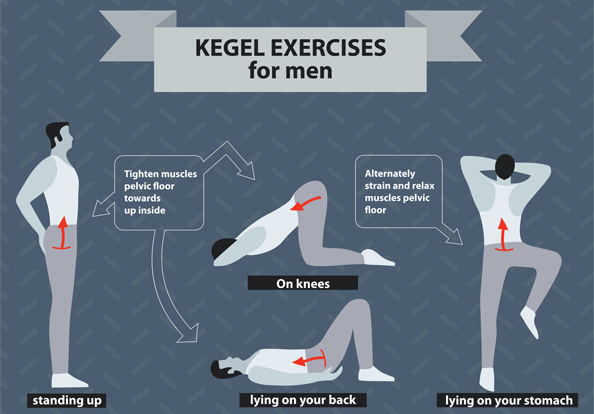Discover how incorporating kegel exercises into your routine can not only strengthen your pelvic floor but also ease knee pain.
Table of Contents
- Introduction: Jump into a Pain-Free Life!
- What Are Kegel Exercises?
- Knee Pain Woes
- Connecting the Dots: Kegels and Knees
- Benefits Beyond the Knees
- When Not to Kegel
- How to Do Kegel Exercises Safely
- Making Kegel Exercises Fun!
- Checking Your Progress
- Summary: Why Kegels Might Be Your Knee’s New Best Friend
- FAQs: All Your Kegel Curiosities Answered!
Introduction: Jump into a Pain-Free Life!
Imagine waking up every morning with a spring in your step, ready to take on the day without a single twinge of pain in your knees. Sounds like a dream, right? Well, what if I told you there’s a simple and unexpected way to make that dream a reality? Enter kegel exercises, the unlikely hero in the fight against knee pain!
Let me paint you a picture – you’re playing your favorite game outside, running around with your friends, when suddenly your knees start to ache. It can be frustrating and even scary when your knees hurt, making it difficult to enjoy the things you love. But what if I told you that doing a few kegel exercises each day could make all the difference?
So, let’s dive into this new world of kegel exercises and discover how they can help you jump into a pain-free life!
What Are Kegel Exercises?
Kegel exercises are a type of exercise specifically aimed at strengthening the pelvic floor muscles. These exercises involve contracting and relaxing the muscles around the pelvis in a repetitive manner to improve muscle tone and control.
Kegel Exercises: The Basics
Imagine squeezing the muscles you would use to stop the flow of urine. That squeezing action is similar to what you do during kegel exercises. You can do kegel exercises almost anywhere, whether you’re sitting, standing, or lying down.
The Muscles Involved
The muscles you work during kegel exercises are the same ones that support your pelvic organs, bladder, and bowels. These muscles play a crucial role in controlling your urination and bowel movements.
Knee Pain Woes
Knee pain is something that almost everyone experiences at some point in their lives. Whether you’re a kid running around on the playground or an adult going for a jog, knee pain can be a real nuisance. The most common causes of knee pain include injuries from falls or sports, overuse from repetitive movements, or conditions like arthritis that affect the joints. Sometimes, even something as simple as a misaligned kneecap or flat feet can lead to knee discomfort.

Image courtesy of www.healthproductsforyou.com via Google Images
Regardless of the cause, knee pain can impact your daily activities and make it hard to move around comfortably. This is where understanding the importance of taking care of your knees becomes vital. By learning how to protect your knees and strengthen the muscles around them, you can help prevent and alleviate knee pain, allowing you to live a more active and pain-free life.
Connecting the Dots: Kegels and Knees
When you think of exercises that can help with knee pain, kegel exercises might not be the first thing that comes to mind. But believe it or not, these simple workouts can actually play a role in alleviating aching knees. Let’s dive into how kegels and knees are connected.
How Kegel Exercises Can Help
So, how exactly can doing kegel exercises help with knee pain? Well, it all comes down to the muscles involved. When you do kegels, you’re targeting and strengthening the pelvic floor muscles. Strengthening these muscles can indirectly help support your knees.
Benefits Beyond the Knees
When it comes to kegel exercises, the benefits go beyond just easing knee pain. Strengthening your pelvic floor muscles through kegel exercises can actually have a positive impact on other parts of your body as well. Let’s explore some of the additional health benefits associated with kegel exercises.

Image courtesy of www.pratisandhi.com via Google Images
Ease Your Lower Back Pain
Did you know that a strong pelvic floor can also support your lower back? By engaging in regular kegel exercises, you can help improve your core strength and stability, which in turn can alleviate lower back pain. So, not only will you be working towards pain-free knees, but you’ll also be benefitting your back at the same time.
Say Goodbye to Tension Headaches
Another surprising benefit of kegel exercises is the potential to reduce tension headaches. How is that possible? Well, when your core muscles are strong and your posture improves as a result, you’re less likely to experience the neck and shoulder tension that can lead to headaches. So, by incorporating kegel exercises into your routine, you may find yourself saying goodbye to those pesky tension headaches.
When Not to Kegel
While kegel exercises can be beneficial for many people, there are certain situations where you should proceed with caution or avoid them altogether. It’s important to listen to your body and consult with a healthcare professional if you have any concerns.
Stomach Ulcers and Kegel Caution
If you suffer from stomach ulcers, it’s crucial to be careful when engaging in kegel exercises. The strain of these exercises can potentially exacerbate the discomfort associated with stomach ulcers. It’s best to consult with your doctor before starting any new exercise regimen if you have stomach ulcers.
Rheumatoid Arthritis: Being Careful with Exercise
For individuals with rheumatoid arthritis, caution is advised when it comes to kegel exercises. Strenuous physical activities can sometimes worsen the symptoms of rheumatoid arthritis, so it’s essential to approach kegels with care. Consulting with a healthcare provider who is familiar with your condition can help determine the suitability of kegel exercises for you.
How to Do Kegel Exercises Safely
Performing kegel exercises safely is important to prevent any injuries and maximize the benefits for your body. Here’s a simple guide on how to do kegel exercises correctly:

Image courtesy of www.pinterest.com via Google Images
Kegel Exercises: The Basics
Start by finding a comfortable and quiet place to do your kegel exercises. Sit or lie down with your muscles relaxed.
Then, tighten the muscles in your pelvic floor as if you are trying to stop the flow of pee. Hold this squeeze for about 5 seconds.
Relax your muscles for another 5 seconds before repeating the squeeze. Aim to do 10-15 repetitions in one session.
The Muscles Involved
Kegel exercises target the muscles in your pelvic floor, which support your bladder, uterus, and bowels. Strengthening these muscles can help improve bladder control and support your spine.
Remember to breathe normally while doing kegel exercises and avoid holding your breath.
If you’re unsure if you’re doing kegel exercises correctly, consult a healthcare professional for guidance.
Making Kegel Exercises Fun!
When it comes to helping your knees feel better, kegel exercises may not sound like the most exciting option. But guess what? You can actually make kegels fun by incorporating them into activities you already enjoy!
| Benefit | Description |
|---|---|
| Strengthen Pelvic Floor Muscles | Kegel exercises can help strengthen the pelvic floor muscles which can alleviate knee pain by improving overall stability and support in the lower body. |
| Improve Joint Alignment | By strengthening the muscles around the hips and pelvis, Kegel exercises can help improve joint alignment, reducing strain on the knees and decreasing knee pain. |
| Enhance Core Stability | Strong pelvic floor muscles can improve core stability, which in turn can help to reduce pressure on the knee joints during movement, ultimately decreasing knee pain. |
| Support Posture | Improved pelvic floor muscle strength can also support better posture, reducing strain on the knees and promoting healthy alignment of the entire body. |
Get Moving with Kegel Exercise Challenges
Challenge yourself and your friends to see who can hold a kegel exercise the longest while doing different activities like jumping jacks, dancing, or playing tag. It’s a fun way to strengthen those muscles without even realizing it!
Turn Daily Chores into Kegel Workouts
Next time you’re brushing your teeth, waiting for the school bus, or even watching TV, squeeze and hold your kegel muscles. It’s a simple way to sneak in some exercise while going about your day.
Make a Kegel Exercise Playlist
Create a special playlist of your favorite songs that are about 2-3 minutes long. Every time you hear a song on your playlist, do kegel exercises until the song ends. You’ll be having so much fun dancing and moving to the music that you won’t even realize you’re working out!
By making kegel exercises fun and part of your daily routine, you can help ease knee pain while enjoying yourself at the same time. So, why not give these ideas a try and make your kegels more enjoyable?
Checking Your Progress
As you continue to incorporate kegel exercises into your daily routine to help with your knee pain, it’s essential to keep an eye on your progress. By tracking how your body is responding to these exercises, you can better understand their impact on your knee pain and overall well-being.

Image courtesy of www.avogel.co.uk via Google Images
Tracking Kegel Strength
One way to monitor your progress with kegel exercises is by paying attention to how strong your pelvic floor muscles feel. As you consistently engage in these exercises, you may notice an increase in muscle tone and control in this area of your body. This increased strength can contribute to better support for your knees and may help alleviate pain over time.
Monitoring Knee Pain Reduction
Another crucial aspect of tracking your progress is keeping tabs on any changes in your knee pain levels. Be mindful of how your knees feel before and after performing kegel exercises. Are you experiencing less discomfort or stiffness? Are you able to move more freely without as much pain? By noticing these changes, you can gauge the effectiveness of kegel exercises in managing your knee pain.
Remember, progress may not happen overnight, so be patient with yourself as you embark on this journey to ease your knee pain with kegel exercises. By staying consistent and monitoring your progress, you can take proactive steps towards a healthier, pain-free lifestyle.
Summary: Why Kegels Might Be Your Knee’s New Best Friend
So, what’s the deal with kegel exercises and knee pain? Well, kegel exercises, typically known for targeting pelvic floor muscles, can actually play a surprising role in relieving knee pain. By strengthening those muscles, you’re indirectly supporting your knees too!
Strengthening the Core for Healthy Knees
When you engage in kegel exercises, you’re not only toning your pelvic floor but also stabilizing your core. This core strength helps to improve your posture and balance, ultimately reducing the stress on your knees. Imagine kegels as a secret weapon, quietly working behind the scenes to keep your knees happy and pain-free.
Beyond Knee Pain: Added Benefits
But the perks of kegel exercises don’t stop at knee pain relief. Strengthening your pelvic floor can also alleviate lower back pain by providing additional support to your spine. And with improved posture from a strong core, you may even bid farewell to tension headaches that often result from slouching or poor alignment.
So, while kegel exercises may seem like a small part of your fitness routine, they can have significant impacts on various aspects of your health.
FAQs: All Your Kegel Curiosities Answered!
Do Kegel exercises only help with knee pain?
No, kegel exercises are not just beneficial for knee pain. While strengthening the pelvic floor muscles can indirectly help alleviate knee pain, these exercises also offer a range of other health benefits. Kegels are known to help with lower back pain, tension headaches, and even improve bladder control.
Can anyone do Kegel exercises?
Yes, kegel exercises are safe for most people to do. However, if you have specific health conditions like stomach ulcers or rheumatoid arthritis, it’s essential to consult with a healthcare provider before starting any new exercise routine. They can provide guidance on whether kegel exercises are suitable for you.
How often should I do Kegel exercises?
Regular practice is key when it comes to kegel exercises. Aim to do these exercises consistently, ideally incorporating them into your daily routine. Start with a few sets of kegels each day and gradually increase the repetitions as your pelvic floor muscles get stronger.
Are Kegel exercises difficult to do?
Kegel exercises are relatively simple and can be done anywhere, anytime. To perform a kegel, simply squeeze the muscles you would use to hold in urine for a few seconds and then release. Remember to breathe normally throughout the exercise and avoid holding your breath.
What age should I start doing Kegel exercises?
While kegel exercises can benefit individuals of all ages, it’s never too early to start practicing them. Developing strong pelvic floor muscles early on can help prevent issues like incontinence and pelvic floor dysfunction later in life. Kids and adults alike can benefit from incorporating kegel exercises into their daily routine.





